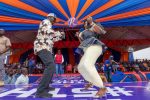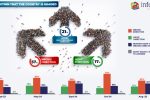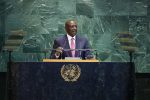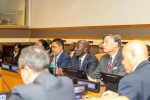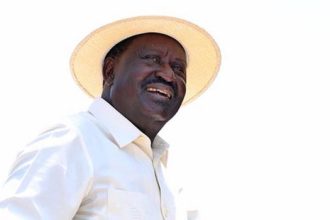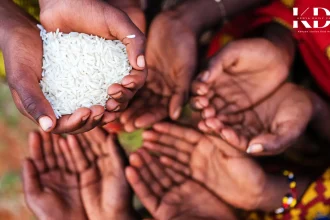Since the death of Kenya’s former Prime Minister Raila Odinga, everyone has, and rightly so, used Harry Belafonte’s Jamaica Farewell to illustrate his live for music.
There are multiple times that Raila was captured singing this song and many others. And with that there has been no doubt in anyone’s mind that Raila loved music
For more than two decades, Raila’s political journey has been as much a story of sound as it has been of speeches and strategy.
His rallies were never just political gatherings; they were concerts of conviction, full of rhythm, chant, and emotion.
Over the years, music became a constant companion to his campaigns, shaping his message, rallying his supporters, and giving voice to the ideals that defined his political life.
In Kenya, politics and music share a long and intertwined history.
Songs have often served as tools of resistance, instruments of hope, and vehicles for uniting people across class and tribe.
In Raila’s case, each of his presidential bids carried with it a soundtrack, melodies that mirrored the mood of the moment, lyrics that captured the spirit of his movement, and beats that echoed through the nation long after the votes were counted.
The story begins in 2002, when Kenya stood on the brink of change.
After decades of KANU’s dominance, a coalition of parties under the National Rainbow Coalition (NARC) banner rose to challenge the status quo.
Their campaign found its anthem in “Unbwogable” by Gidi Gidi Maji Maji, a youthful duo whose defiant song, meaning “unshakeable”, quickly transcended pop culture to become a political statement.
The chorus, chanted by crowds across the country, captured the public’s hunger for transformation.
Though not written as a political song, “Unbwogable” became inseparable from the campaign that ultimately ended KANU’s long reign, with Raila playing a central role in the coalition.
A decade later, in the 2013 and 2017 campaigns, Raila’s political messaging once again found a musical partner, this time in “Mambo Yabadilika” by Hellenah Ken.
The gospel-inspired track, which translates to “Things Will Change,” carried a message of hope and renewal that resonated deeply with his supporters.
It echoed Raila’s promise of a new Kenya where justice, equity, and opportunity would be within reach for all.
The song’s uplifting tone gave the campaign a spiritual texture, tapping into Kenya’s strong faith traditions while affirming that political change was not just possible, but divinely ordained.
Around the same period, another song, “Nobody Can Stop Reggae” by South African legend Lucky Dube, found new life in Kenyan politics.
It became an unofficial soundtrack for Raila’s defiance, particularly during the “handshake” and Building Bridges Initiative (BBI) era.
To his supporters, the reggae metaphor symbolised a movement too strong to be silenced. Raila himself would often invoke the phrase at rallies, smiling as crowds responded in unison.
It became shorthand for persistence, a declaration that despite setbacks, the struggle would go on.
The 2017 election also produced one of the most memorable political anthems in Kenya’s recent history: “NASA Tibim” by Onyi Jalamo.
The song, created for the National Super Alliance (NASA) coalition, swept across the nation with infectious energy.
Its rhythmic chants of “Tibim” and “Tialala” became rallying cries, reverberating from matatus to market stalls.
More than just a campaign song, it was a declaration of solidarity, one that blended Luo cultural beats with national political fervour.
By 2022, Raila’s campaigns had embraced modernity and multimedia in new ways.
His main campaign anthem, “Lero ni Lero” was a collaboration between the veteran Luhya musician Emmanuel Musindi and Raila himself.
The song’s message was simple but powerful: “Today is today”, a call to action, urging Kenyans to seize the moment.
With Raila’s voice woven into the track, it became both personal and participatory, symbolising how deeply intertwined he had become with Kenya’s musical and cultural fabric.
Beyond official campaign tracks, many of Raila’s political moments were marked by spontaneous songs of resistance.
Chants like “Bado Mapambano”, meaning “The struggle continues”, became staples of his rallies and protests, sung passionately by crowds during demonstrations.
Similarly, the protest anthem “Sitarudi Nyuma” (“I will not go back”) often echoed through the streets during opposition marches, embodying a spirit of endurance that mirrored Raila’s own political resilience.
What made these songs endure was not just their rhythm or melody, but what they represented.
They were expressions of identity and belonging, often infused with local languages and sounds that reflected Kenya’s cultural diversity.
They were built around simple, repeatable phrases “Unbwogable,” “Inawezekana,” “Leo ni Leo”* that turned into slogans, chants, and rallying cries.
They bridged generations, pulling together youth energy and veteran loyalty into one shared experience.
For Raila, music was never mere background noise. It was part of the message. Through it, he communicated hope, defiance, and faith in the Kenyan dream. Each song told a piece of his story, a story of struggle, perseverance, and belief in change.
As Kenya reflects on Raila Odinga’s political legacy, these songs remain more than campaign memories.
They are part of the country’s cultural archive, reminders of moments when melody met movement, and when politics found its beat. Whether one agreed with his politics or not, it is impossible to deny that Raila’s campaigns changed how Kenya heard politics.
From “Unbwogable” to “Lero ni Lero”, his political soundtrack remains etched in the nation’s consciousness, a symphony of struggle, hope, and resilience that will long outlast the rallies it once powered.
